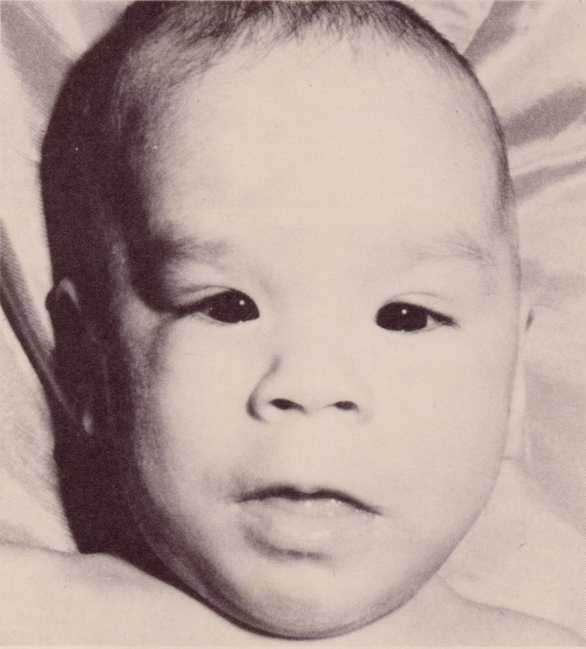SUSAN B. is a middle-class housewife and mother of two teenagers.
Her husband Ted and sons Gary and Tony — we shall call them — have grown accustomed to preparing their own breakfasts. They don't disturb Mother in the mornings. Susan suffers from insomnia and various nervous disorders. Her doctor prescribed a tranquilizer.
Susan feels that the prescribed tranquilizer, along with the mixed drinks she has at lunch and each evening before bedtime, calms her nerves. Does Susan have a developing problem with alcohol?

TYPICAL ABNORMALITIES OF FETAL ALCOHOL SYNDROME BABIES are
flat mid-face, smaller-than-average eyes, long thin upper lip, short nose,
epicanthic folds on upper eyelids, low nasal bridge and facial asymmetry.
Courtesy of the University of Washington
|
Karen T. is in her late twenties, and works in the local high school office. She usually arrives home before her husband Fred and has a hot meal waiting when he arrives. She and Fred always have wine with their dinner. Before Fred's arrival while preparing the meal, Karen usually sips wine to relax after work.
Karen is anticipating her husband's arrival even more so this particular evening. She has a couple of bottles of champagne chilling to celebrate his new promotion.
By 9 o'clock that evening, Karen, without a word, rises and unsteadily leaves the living room for bed. Fred watches her. She's overdone it again. He knows better than to berate her — it would only mean another nasty argument that Karen would probably not remember anyhow. Is Karen a problem drinker?
Joyce G. juggles her bag of groceries, files and papers as she retrieves her key from her front door. Pushing the door open with her foot, she deposits her groceries and papers on the kitchen table. Then, lifting a gallon of white wine from her grocery bag, Joyce removes the seal and stopper and fills a large water glass with ice cubes and wine.
|
She slips off her shoes, extinguishes her cigarette, and, with her work from the office, curls up on the couch. Before long Joyce refills her glass, carrying the bottle back with her to the couch.
Next morning, Joyce, feeling queasy, her head throbbing, showers, struggles into fresh clothing, pulls a brush through her hair and hurries off to work. Most of Joyce's evenings are spent in much the same fashion. Is Joyce an alcoholic?
Pregnancy and Alcohol
Whether your answer would be yes or no in any of these cases, if either Susan, Karen or Joyce were pregnant and her particular doctor was aware of her drinking habits, an abortion would most likely be recommended.
Doctors have strongly suspected for years the link between this kind of alcohol consumption by pregnant women and brain damage in their children. Early in 1981, however, the first direct evidence was announced by University of Iowa researchers.
The American researchers proved with experimentation on rats that prescribed levels of alcohol consumed by the mother rat caused abnormal brain circuitry in her unborn offspring — damage that continued into adulthood. Their findings appeared in the February 27, 1981 issue of Science, the journal of the American Association for the Advancement of Science.
Fetal alcohol syndrome (FAS) has been notably associated with abnormal physical characteristics — usually a small head and various facial deformities such as flat mid-face, smaller-than-average eyes, long thin upper lip, short nose, epicanthic folds on upper eyelids, low nasal bridge and facial asymmetry, along with low birth weight and size. Skeletal abnormalities have been added to the list.
Dr. Patrick M. MacLeod, a Canadian medical geneticist, warns, "It is important to diagnose the skeletal abnormalities because these children have a greater risk of dislocating their necks in the rough-and-tumble activities of informal play or gym" (Medical World News, August 6, 1979).
Alcohol flows easily from a mother's bloodstream through the placenta into her unborn child. The odds of damaging the fetus go even higher when drugs are combined with alcohol by the pregnant mother.
Research is also being done on the possibility that a drinking father may contribute to birth defects or fetal death. Initial research shows a greater percentage of birth defects in children of fathers who drink heavily.
We shouldn't be surprised to find that a substance used to kill bacteria would interfere, when taken in significant amounts, with the development of a tiny, delicate fetus.
A Safe Drinking Level
And how much is too much? Is there a safe drinking level for a pregnant woman? Most all authorities would agree that there are definite risks beyond three ounces of alcohol a day. Studies show about
11 percent of the children of women who drink even one to two ounces of alcohol a day had developmental problems.
The decision by a pregnant mother to drink an alcoholic beverage should certainly be arrived at by taking into consideration metabolic and other factors such as weight, diet and drugs used, illicit or otherwise.
In the United States the National Council on Alcoholism (NCA) concludes that pregnant women, to be on the safe side, should not drink any alcoholic beverage.
A Leading Cause of Birth Defects
Tragically, fetal alcohol syndrome is one of three leading birth defects in the United States. And the only one apparently so easily preventable.
Readers of The Plain Truth are responsible for this kind of demonstrable information just as much as we are all held responsible for the knowledge we have of that conspicuous warning on cigarette packages. Perhaps smokers before the seventies could at least claim ignorance as an excuse. But no longer.
And no longer can those who indulge in alcohol and drugs justify the abuse to their bodies and those of their offspring.
You have the knowledge. What are you going to do about it?